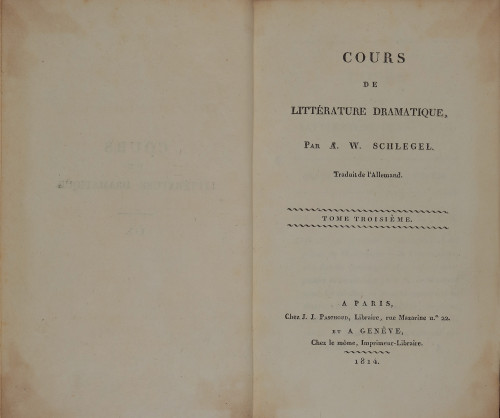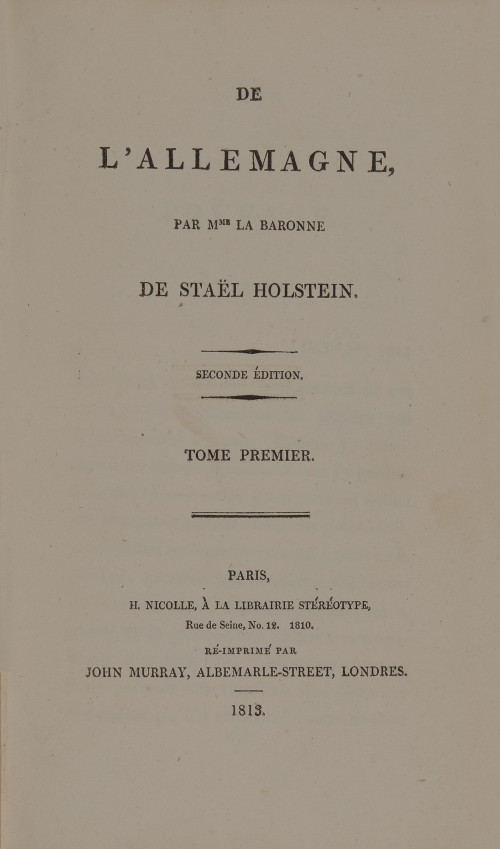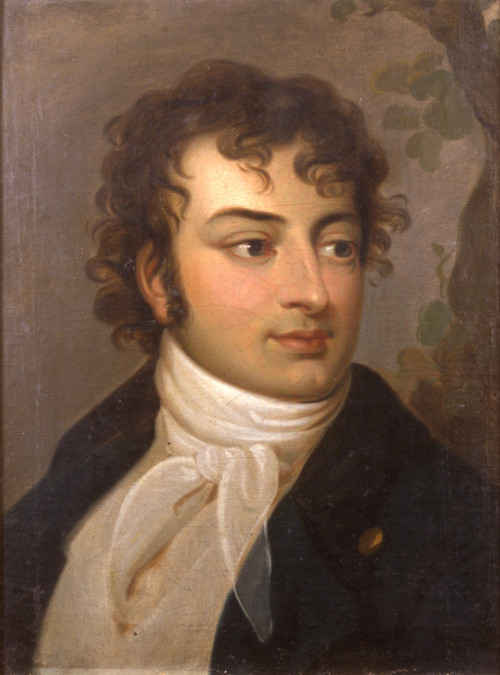August Wilhelm Schlegel was one of the very first Romanticists. The portrait shows him as a young man with unruly curls in a natural setting. It dates from the early phase of his career, before he had made a name for himself.
After Romanticism got off to a brilliant start in Jena, Schlegel consolidated its artistic aims by placing them in a broader context. In a series of lectures he gave in Berlin between 1801 and 1804, he traced the movement back to the Middle Ages. He then went on to spread his ideas in the lecture series A Course of Lectures on Dramatic Art and Literature, given in Vienna. He cited the Baroque playwrights Shakespeare and Calderón as two of the most original exponents of modern, “romantic” dramatic art, which he juxtaposed with that of classical antiquity. The well attended lectures were veritable social events. They appeared in print between 1809 and 1811, bringing translations into several European languages in their wake.
The French writer Anne-Louise-Germaine de Staël, whose acquaintance Schlegel had made in Berlin in 1804, energetically helped to spread his ideas. Prohibited from staying in Paris for her involvement in anti-Napoleonic activities, she set out on extensive travels through Germany in October 1803. Never before had a woman’s tour of a foreign country received such publicity. She met with many celebrities along the way, among them Goethe in Weimar, whose best-selling novel The Sorrows of Young Werther she considered one of the most important books of the day. She was enthralled with Schlegel’s intellectual abilities, and he was quite taken with her as well. She hired him as a private tutor for her children and her advisor on all literary matters. He helped her gain an understanding of German culture and supported her in the composition of her major book on Germany, De l’Allemagne. It was scheduled to come out in 1810, but the French minister of police had the printed pages pulped: The authorities accused the work of presenting the French with an ideal of Germany that could be construed as a criticism of Napoleonic France. Schlegel had saved a proof, however, enabling Madame de Staël to publish her book after all—in London in 1813. Following an introduction to the land and the people, it sheds light on literature, philosophy, and religion in Germany. Goethe figures prominently, and an entire chapter is also devoted to the Schlegel brothers. The author’s aim was to acquaint her compatriots with the neighbouring country as a way of enlivening France’s austere Neoclassicist literature with new ideas. And indeed, her work would come to play a key role in the emergence of Romanticism in France.
Yet De l’Allemagne also held up a mirror to the Germans, who were undoubtedly piqued by some of de Staël’s remarks. Overall, however, her enthusiastic portrayal of their country as a “land of poets and thinkers” will surely have delighted them.
Objects
-

AUGUST WILHELM SCHLEGEL
A Course of Lectures on Dramatic Art and Literature, by Augustus William Schlegel
Translated from the Original German by John Black. 2 Bände. London: Baldwin, Cradock and Joy; Edinburgh: Blackwood; Dublin: Cumming 1815.
-

GERMAINE DE STAËL (1766‒1817)
De l’Allemagne, par Mme la Baronne de Staël Holstein.
London: Murray 1813.
-

Unbekannt
August Wilhelm Schlegel, um 1800/1802
-
AUGUST WILHELM SCHLEGEL
Über das Mittelalter. Eine Vorlesung (1803)